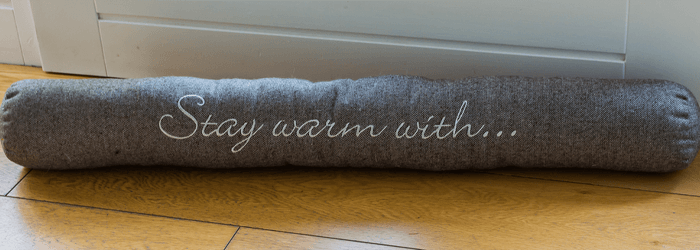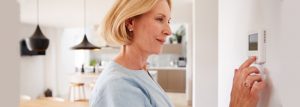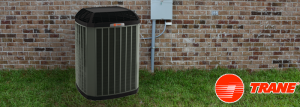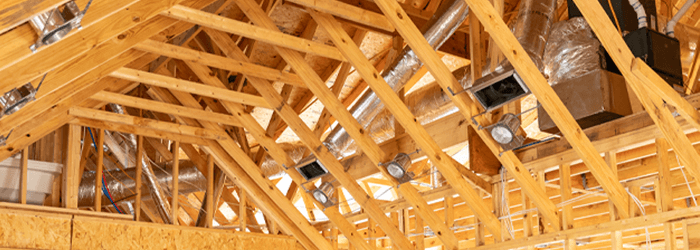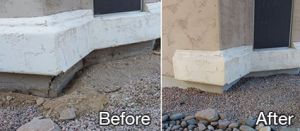The time will come when we seek some indoor heat. From your central heating system to your honey, there are a lot of heating options to choose from. Let’s take a look.
Electric Blankets
This is a topic we have not covered, and holy smokes, we found some comprehensive and amazing information about the use of electric blankets from the Electric Blanket Institute – yeah, there’s an institute for electric blankets! The following is what they have to say, and they have a lot!
How does an Electric Blanket Work?
An electric blanket isn’t a piece of bedding. It is a household appliance because it works similarly to all other devices in your home. You plug it in the outlet, and it uses your circuit.
Electric Blankets Construction
Electric blankets are multilayer and contain small, thin coil wires, capable of carrying heat through the fabric. The wires transfer heat to the blanket, and the blanket transfers heat to you. The electric blanket uses 120 V of electricity to heat the coil wires to the desired temperature.
With some high-quality blankets, you won’t feel the wires because they are thin and densely woven with the fabric.
Electric Blankets Features and Safety Aspects
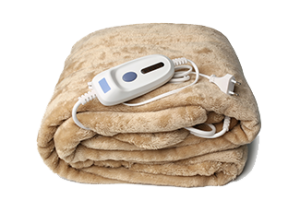
Like all electrical appliances, blankets come with user-friendly attributes, instructions for use and maintenance, and safety features.
Heat Settings
Modern electric blankets have multiple heat settings and can be set to 10 or more heat levels. Basic electric blankets can heat at low, medium, or high temperatures.
Controllers
Electric blankets come with easy-to-use and read controllers. Some are more complex and come with timers, while others have just two or three buttons to set the temperature.
Controllers are to be detached for maintenance and cleaning and assembled back for use. It is crucial to detach and assemble controllers back correctly, to prevent malfunctions that can cause fire or burns.
Thermostats
The majority of modern electric blankets come with thermostats or temperature gauges, both user-friendly and as a safety feature.
Blankets with thermostats can detect the current temperature of your body and the blanket itself and adjust the settings to reach or maintain the temperature you want. Therefore, the blanket won’t raise the temperature needlessly to keep you warm. Working on lower temperatures significantly decreases the chances that the blanket will overheat.
Automatic Shut-Off and Timers
An automatic shut-off will make your blanket stop emitting heat when the internal temperature of the blanket reaches a certain level.
Blankets are tested for high temperatures. The automatic shut-off feature will prevent overheating or possible fire issues. Once the blanket reaches a dangerous level of heat, it will stop working before it can cause a fire or malfunction.
Carbon Fiber Wire
The latest safety improvement is carbon fiber wires. These wires are commonly found in the vehicle industry and used in seat heaters. They provide additional safety and lower the risk of burns even more.
Carbon wires ensure durability and prolonged safe use of electric blankets.
NEVER make your own electric blanket. Only blankets that are manufactured in specific conditions that have passed quality control and are aligned with UL 964 standards are safe to use. DIY electric blankets can cause fire and burns, resulting in severe injuries.
Low-Voltage Operation
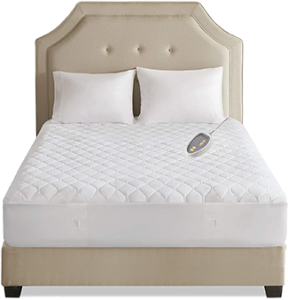
Another excellent improvement in the safety aspects of electric blankets is a low-voltage operation. Standard electric blankets operate at 120 V of AC current.
Low-voltage blankets convert to non-hazardous (and less potent) DC current. Therefore, the low-voltage blanket doesn’t have enough power to keep the entire bed warm, but it can keep a person warm and cozy underneath the blanket. There is no unnecessary waste of energy and heat.
Because of low-voltage settings, the blanket costs less to run. However, you will need several days to get used to a low-voltage blanket and to find the settings that work best for you.
Rosie and I like this product, the Beautyrest 3M Scotchgard Heated Mattress-Pad.
It is a bit different than a blanket. It warms the bed nicely before you get in. For people like us who like the air cool and sleep with the room cool (cold) and the doors open, it is a good option. Turn it on an hour before you turn in for the night and you won’t get cold sheet shock. It is like getting a hug. Blankets can be smothering, and you find yourself pulling them up and down. The pad gives you better control of the heat. Choose one that warms both sides separately!
Improper Electric Blanket Maintenance and Use
Each blanket is tested for safety. If it passes, the blanket is released on the market. Blankets come with specific instructions for maintenance and warranty. Improper use and maintenance increase the risks of fires and injuries.
According to Electricblanketfires.com, in the USA, there are around 5,000 fires caused by electric blankets annually. The most common causes of fires are improper handling, manufacturing mistakes, and blanket wear and tear.
The most frequent injuries are heat contact, caught fire, smoldering, and electrocution. Therefore, it is essential to follow the instructions to keep your blanket safe for use.
Improper Care
An electric blanket needs to be washed, but only according to the instructions. The electric blankets on the market are safe to machine wash and can be placed in a dryer. Check the product specifications to make sure washing in the machine won’t void the warranty. Before you put the blanket in the machine, inspect it for its condition. If wires are poking through the blanket, stop using it immediately. Don’t wash it or use it ever again.
If the blanket is in good condition, detach controls using steps noted in the blanket manual.
Dry the blanket in a dryer for 15 minutes. Use cold temperatures for both washing and drying.
Improper Use
- NEVER use an electric blanket with a waterbed, sofa bed, recliner, or hospital bed.
- NEVER use an old electric blanket that shows signs of tears, discoloration, stains, poking wires, etc. Plus, old blankets don’t have new and improved safety features such as thermostats or auto-shutoff features.
- Don’t place anything on top of the blanket.
- Don’t sit or lay on your electric blanket because it can damage the wires.
- Electric blankets should be kept outside the reach of children and pets.
- NEVER put the cable underneath the mattress. The cables can overheat and cause a fire.
Electric Blankets Safe Storage
When not in use, unplug the cords and controls, fold loosely, place in a plastic bag, and store in a dry place, such as on an indoor closet shelf.
Who Shouldn’t Use an Electric Blanket?
An electric blanket is generally safe to use. However, not all people, particularly those with certain medical conditions should use it. Before using an electric blanket, consult with your doctor.
Note that electric blankets should never be used on babies and people with mobility challenges. They cannot detect and react if the blanket is malfunctioning which can cause burns and severe injuries.
Central Heating System
If you did not do this already, do it now. Schedule an appointment with an HVAC company to ensure your heating system is tuned up and ready to be turned on.
If you have gas heat, the tune-up should include a full inspection of the unit, including a safety check of the gas line and the ignitor. An electric heat pump should be serviced once a year, ensuring the reversing valve is properly working. Ask the service provider if they offer energy audits (usually only $99). If so, have that performed at the same time.
Fireplace
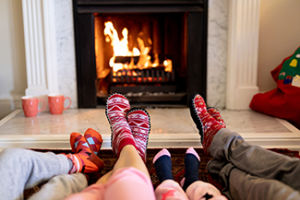 In a wood-burning fireplace, the wood never burns completely. The creosote that builds up over time is highly flammable. Cleaning needs to be done before the first fire of the season.
In a wood-burning fireplace, the wood never burns completely. The creosote that builds up over time is highly flammable. Cleaning needs to be done before the first fire of the season.
Keeping the fireplace and chimney clean is a safety issue. The care is different for wood-burning and artificial gas-heated logs.
It is recommended that you have the chimney cleaned every five years or for every chord of wood you burn-whichever comes first. Creosote build-up is a fire hazard. Arizona Chimney & Air Ducts, a Rosie-Certified Partner, says a full inspection of your fireplace should include the flu, flue pipe, and damper.
For gas-burning logs, have the gas fittings, flue, and flue pipe, checked. Get the gas log set cleaned, too. With gas logs, the flue must be left partially open in the event of a gas leak.
If your fireplace has a direct vent, generally behind a glass sheet, have that checked as well.
Some counties, particularly Maricopa, have many no-burn days. You may want to consider changing your wood-burning fireplace to a gas fireplace so you can enjoy the warmth and ambiance without worrying about getting a fine.
Space Heaters
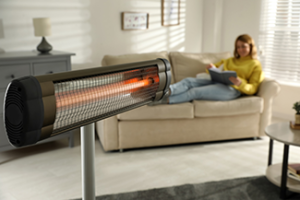 An electric space heater can be just the thing to warm up a particularly cool spot in your home when it’s not quite cold enough to crank up the central heating system.
An electric space heater can be just the thing to warm up a particularly cool spot in your home when it’s not quite cold enough to crank up the central heating system.
Exercise caution when using a space heater. The National Fire Protection Association reports that space heaters are the type of heating equipment most often involved in home heating fires, accounting for 86 percent of associated civilian deaths, 78 percent of civilian injuries, and 54 percent of direct property damage.
The NFPA suggests:
- Purchase a heater with the seal of a qualified testing laboratory.
- Keep the heater at least 3 feet away from anything that can burn, including people.
- Choose a heater with a thermostat and overheat protection.
- Place the heater on a solid, flat surface.
- Make sure your heater has an auto shut-off to turn the heater off if it tips over.
- Keep space heaters out of the way of foot traffic. Never block an exit.
- Keep children away from the space heater.
- Plug the heater directly into the wall outlet. Never use an extension cord.
- Space heaters should be turned off and unplugged when you leave the room or go to bed.
- Plug your bathroom space heater into a ground-fault circuit interrupter.
- Don’t hide the electric cord under a rug or carpet. The cord could overheat and cause a fire.
- Leave three feet of space between the heater and furniture and even walls.
- Keep it away from anything flammable.
Your Honey
If you share a bed with someone, one of you probably runs hotter than the other. So, snuggle up and share some body heat. At least one of you will get a good night’s sleep.
Your Pets
Cats and small dogs make great foot, head, and hand warmers. Fish and reptiles, not so much.
###
PODCAST
We discuss why November/December is the right time to examine your energy bill and check the cost of summer cooling. We also talk about why some rooms are hotter or cooler that others in the home. Now that it’s cooler, what’s the safe temperatures for your water heater? Plus other ways to keep warm while looking ahead to the heat of next summer.
Photo Credit
- Beautyrest
- Shutterstock

